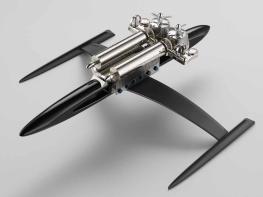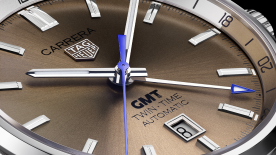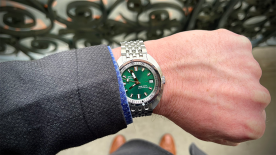MusicMachine is a music box that looks and sounds out of this world. It contains all the traditional, time-honoured elements of a superlative high-end music box, but designed and configured in a totally unconventional way.
But then you would expect nothing less from a collaboration between REUGE and MB&F. REUGE, the premier manufacturer of music boxes on the planet, with nearly 150 years of expertise and experience. And MB&F, the award-winning artistic and micro-engineering laboratory acclaimed for its avant-garde, three-dimensional Horological Machines.
With its dual propellers and twin silver cylinders mounted on sleek outrigger landing gear, MusicMachine looks like a spaceship hailing from a galaxy far, far away.
Each of the cylinders on MusicMachine plays three tunes, all personally selected by MB&F founder and creative director, Maximilian Büsser. On the left, “may the Force be with you” with the ‘Star Wars’ theme, ‘Imperial March’ from ‘The Empire Strikes Back’, and the theme from ‘Star Trek’. Back on earth, the right cylinder plays Pink Floyd’s ‘Another Brick in the Wall’, Deep Purple’s ‘Smoke on the Water’ and ’John Lennon’s ‘Imagine’ – all tunes synonymous with MB&F's radical, nonconformist attitude.
“Like many kids, saving the world was my full time job when I was a boy,” says Büsser. “For MusicMachine, I delved into my childhood dreams and fantasies inspired by heroes such as Luke Skywalker and Captain James T. Kirk.”
One of the biggest challenges for REUGE was respecting the mechanical symmetry of MB&F’s design, and it meant breaking with a few music box conventions to achieve it. MusicMachine actually has two independent movements, each comprising: winding propeller; mainspring barrel (looking like a piston under the propeller); horizontal cylinder with pins creating three melodies; and vertical comb with individual hand-tuned teeth sounding each note.
When music is playing, the speed that the cylinder unwinds at is governed by an air regulator in the form of a circular fan outside each propeller-topped, piston-shaped mainspring barrel.
While it would have been much easier to duplicate the two movements and just change the melodies, MB&F's original concept called for perfect symmetry and if the movements were identical, the comb on one cylinder would not be on the outside. So REUGE took the unprecedented step of configuring the two movements as mirror images of one another, which meant completely inverting the design of the movement components and architecture.
The end result is a visual and acoustic tour de force that even sci-fi fan Büsser finds hard to believe: “REUGE is the Jedi master of music boxes. It is incredible how REUGE has been able to turn our design into reality. And that’s not even mentioning how good it sounds!”
REUGE CEO Kurt Kupper is equally delighted with the outcome of the collaboration: “MB&F came to us with this radical concept and we have shown that, when it comes to high-end music boxes, REUGE will make dreams come true.”
MusicMachine: Awe-inspiring to look at, beautiful to listen to… The Force is strong with this one.
MusicMachine is a limited edition of 66 pieces: 33 pieces in white and 33 pieces in black (the latter for those with a preference for 'the dark side').
MusicMachine – a music box not just for the 21st century, but the 25th century!
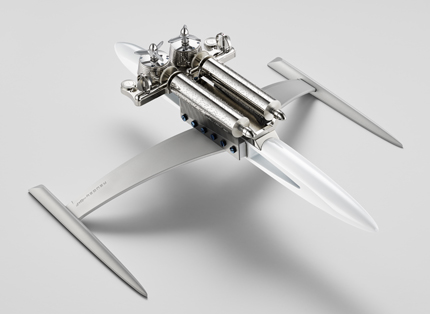
Mechanical Music boxes produce melodies by way of tuned teeth on a steel comb being plucked by pins on a revolving cylinder. Music box movements share many similarities with their horological counterparts, both technically and aesthetically: Energy derived from a coiled spring is transferred by a gear train and the unwinding speed is carefully regulated. High-end music box components are even finely finished similar to high-end watch movements.
No wonder, then, that since music boxes first appeared in the early 19th century, Switzerland, the home of fine watchmaking, became the hub of high-quality music box production. In 1865, Charles Reuge was a pioneer of the genre when he set up his first musical pocket-watch shop in Sainte-Croix, Switzerland. Nearly 150 years on, and REUGE is the premier manufacturer of high-end music boxes on the planet and is still based in Sainte-Croix.
While REUGE's collection has since grown to offer both quintessentially classical pieces and contemporary designs – including a service for specially-commissioned bespoke pieces – with MusicMachine, REUGE has pushed the frontiers of music box design: MusicMachine belongs more to the 25th century than the 21st!
Sci-fi design
REUGE created MusicMachine based on a futuristic spaceship design proposed by MB&F whose founder, Maximilian Büsser, is a keen fan of all the great sci-fi film and TV series. In collaboration with ECAL design graduate Xin Wang, MB&F developed a concept that cleverly incorporated all the essential music box features – musically-tuned combs, pinned cylinders, winding mechanisms, mainspring barrels, regulators and acoustically-optimised case – while still managing to make it look like a streamlined, hypersonic spaceship.
The melodies
MusicMachine doesn't just look like something from a science fiction film; three of the melodies have been beamed directly from sci-fi classics.
On the left cylinder, MusicMachine is armed with the theme from ‘Star Trek’ by Jerry Goldsmith, the theme from ‘Star Wars’ by John Williams and ‘Imperial March’ from ‘The Empire Strikes Back’, also by cinematic music maestro John Williams. While the first two are stirring anthems evoking heroism and adventure, the latter will have you battening down the hatches and raising the shields as it signals the imminent arrival of the villainous Darth Vader.
But MB&F is much more than sci-fi, their creations are edgy and iconoclastic – certainly relative to the rest of the high-end watch world – and this rock ‘n’ roll attitude is neatly conjured in the three melodies contained on the right cylinder: John Lennon’s classic anti-war anthem ‘Imagine’, Deep Purple’s riff-tastic ‘Smoke on the Water’ and Pink Floyd’s memorable social commentary tune ‘Another Brick in the Wall’.
Again Büsser drew on his youth when choosing these, and the selection was a daunting task. “In addition to the science fiction themes, I wanted to include three songs that were important to me during the first 20 years of my life,” he says. “From a long list, I managed to whittle it down to three, but it was quite an ordeal!”
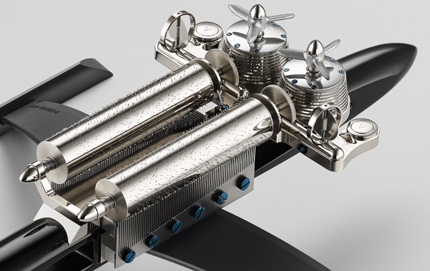
Faithfully creating music… mechanically
Once MB&F had confirmed the melodies, it was over to REUGE to create them mechanically, a challenge that REUGE took in its stride. Firstly, a REUGE musician examined the pieces of music and identified the most recognisable passages from each. The musician then set about recreating these passages for the music box, keeping in mind that one cylinder would contain the three rock melodies, and the other cylinder would have the three sci-fi inspired melodies, and that each cylinder’s pins would pluck one 72-note comb.
Working out these two groups of three arrangements, each one limited to between 25 and 45 seconds, and the multitude of notes that these entail (some notes are used by all three melodies; some notes are exclusive to just one melody) represents a considerable technical and artistic achievement in which the musician’s brain, sense of expression and emotional dexterity top any computer.
The combs
The two vertical combs look like air vent grills on either side of the vessel’s main body. Each comb contains the bespoke selection of 72 notes chosen by the REUGE musician in accordance with the three melodies that cylinder will play. Each comb forms a unique pair with its corresponding cylinder; neither can play properly without the other.
The combs are hand-tuned from a unique steel alloy specifically selected for its acoustic impact. For bass notes, the weight of the tooth is extended at the back by the traditional method of adding lead. A machine then tests the frequency of each tooth and minute amounts of material are removed to accurately tune each note. The hand-operated tools that REUGE uses in this process have all been developed in-house.
Tiny transparent, synthetic feathers are added behind the bass note teeth, acting as dampers so that the note resonates optimally. The comb is finally attached to a brass ‘vibration plate’ passing through the main hull, with six heat-blued screws. The vibration plate transfers the sound to the case, which in turn amplifies the sound even more. Once the comb is fitted, the musician’s ear is required again for the final fine-tune!
The cylinders
The beautifully hand-finished cylinders gleam like a pair of imposing reactors atop MusicMachine’s main hull. The cylinders essentially contain ‘the scores’ of the melodies, with as many as 1,400 precision-placed pins that pluck the teeth of the comb as the cylinder revolves. The REUGE musician determines precisely where to place every single pin. The pins are shaved then polished to ensure uniformity of length. Finally a special hot resin is applied inside the cylinder, which, when hardened, rigidly fixes the pins to maximise sound quality.
Once one melody is played, the cylinder moves slightly along its long axis, and this change of position aligns the right pins with the right teeth to play the next melody. Each melody lasts approximately 35 seconds and corresponds to one complete revolution of the cylinder. The cylinders are linked via visible gear trains to MusicMachine's rear engine-room.
Fan regulators
Either side of the propeller-like winding levers, are distinctive vertical circular panels. While these look as though they may be radar dishes to navigate an asteroid field or force field generating devices to repel enemy proton torpedoes, they are actually the cylinder speed regulators. When fully wound, the main springs tend to turn the cylinders faster than when nearly unwound. To compensate, these circular fan air regulators provide exponentially more resistance when rotating faster than slower, allowing for a constant revolution (a similar system is found in many minute repeater watches).
Fuselage, struts, landing pods and landing platform
Crafted in white or black lacquered walnut, MusicMachine’s sleek fuselage amplifies sound transmitted from the brass vibration plate centrally housed within the case. This plate also conducts the vibrations along the curved, lateral struts and outrigger-style landing pods – in bead-blasted, anodised aluminium (black matte-anodised for the black version) – which in turn carry the vibrations down to MusicMachine’s landing platform. This lacquered timber platform not only further amplifies the enchanting melodies, but also showcases the spacecraft’s aesthetic beauty.
MusicMachine: Technical specifications
MusicMachine is a limited edition of 66 pieces: 33 pieces in white and 33 pieces in black.
Case and frame
Main body: Walnut sound amplification chamber; white or black piano lacquered (white lacquer UV resistant)
Outriggers: Bead-blasted and anodised aluminium; black matte-anodised for black version
Dimensions: 395mm wide x 475mm long x 165mm high; total weight: 2.97kg
Acoustically-enhancing platform: white or black lacquered
Movement and finishing
MusicMachine features two 3.72 movements (3 refers to number of melodies on each cylinder; 72 refers to number of notes on each comb); one movement is ‘right’ configured; one movement is ‘left’ configured (they rotate in opposite directions)
Mainplate: nickel-plated brass, decorated with Côtes de Genève. The mainplate holds both movements; each movement includes a mainspring, cylinder, comb and regulator
Mainsprings: Wound via propellers
Barrels: Stainless steel; each with 6 heat-blued screws on top; grooved 'piston' sides Regulator: fan in stainless steel
Cylinders: brass
Start/stop and continue functions
Cylinder supports: Nickel-plated brass
One melody = one revolution of the cylinder
Three melodies per cylinder
Length of each melody: 35 seconds
Power reserve per cylinder: 15 minutes
Pins hand-applied and hand-polished
Length of pins: 1mm; diameter of pins: 0.3mm
Pins per right cylinder: 1,279; pins per left cylinder: 1,399
Combs: steel alloy and lead; 72 teeth per comb; each comb attached to brass vibration plate by six heat-blued steel screws
Melodies
Right cylinder – extracts from:
‘Another Brick in the Wall’ (1979) by Roger Waters and originally performed by Pink Floyd
‘Smoke on the Water’ (1973) written and originally performed by Deep Purple
‘Imagine’ (1971) written and originally performed by John Lennon
Left cylinder – extracts from:
‘Star Wars’ (1977) main title by John Williams
‘Imperial March’ (1980) by John Williams
‘Star Trek’ (1979) main title by Jerry Goldsmith
